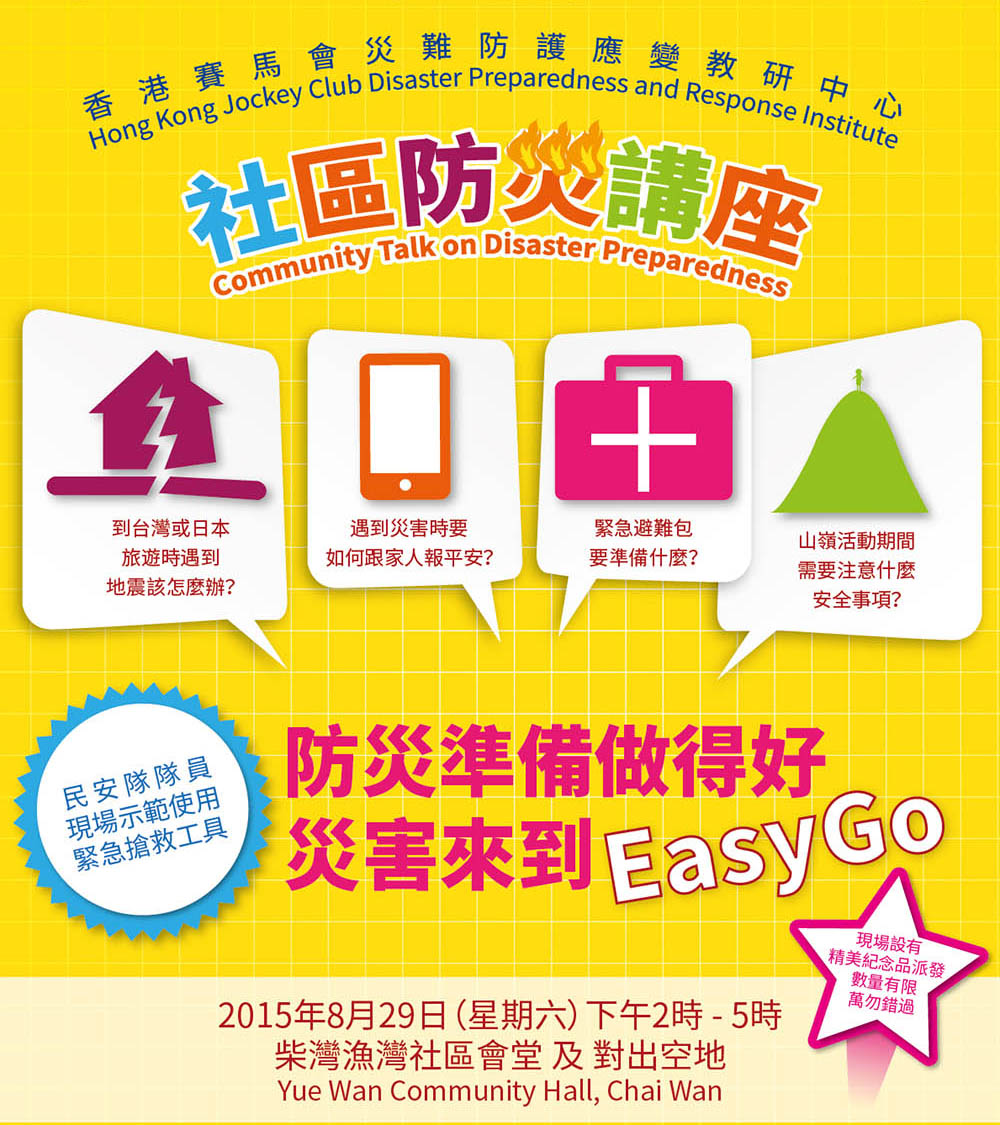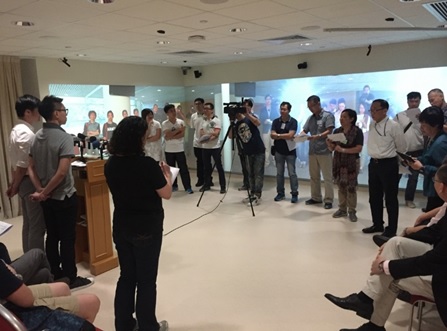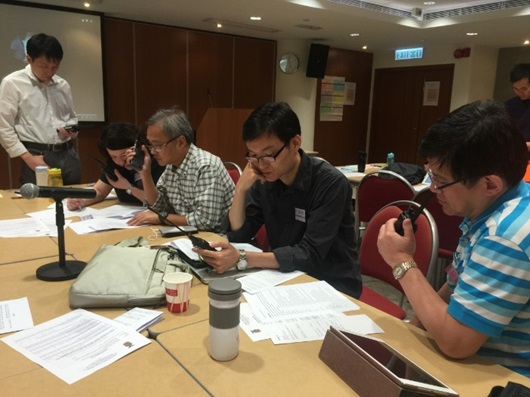Reflection from Taiwan Formosa Water Park Explosion – Are We Prepared for Mass Burns Disaster?
A
terrible explosion occurred at a water park in Taiwan on 27 June 2015. More than 500 people were injured when fire caused by explosion of flammable starch-based power ripped through crowds at a water amusement park in Taipei. As of 23 July 2015, nine fatalities were attributed to the accident and over 100 are still in intensive care.
Acute management of mass burns casualty involves various hospital units such as burns unit, intensive care unit, emergency room, surgical unit, etc, to work together in an effective and timely manner. In this issue of the newsletter, we are honoured to have a renowned burns expert, Professor Andrew BURD, sharing with us his reflections from the Taiwan Formosa Water Park Explosion for Hong Kong.

|
Annual Conference on Disaster Preparedness and Response 2015
 |
The Annual Conference on Disaster Preparedness and Response 2015, titled “From Community to Emergency Room” marks the most significant event of HKJCDPRI, with an aim to strengthen the overall disaster capabilities of Hong Kong community. This unprecedented event is co-organized by the Hong Kong Jockey Club Disaster Preparedness and Response Institute (HKJCDPRI) and the Hong Kong College of Emergency Medicine (HKCEM). Professionals from multiple disciplines, including the Harvard University Delegation, world-renowned experts in disaster management, medical specialists, allied healthcare providers, and NGOs will be united for discussions on disaster policies, best practices, and innovations. The conference will feature three plenaries, over 20 learning tracks on disaster management and emergency medicine topics, pre-conference and post-conference workshops, and poster presentations. The two pre-conference workshops will cover two topics: mechanical ventilation for emergency physicians, and emergency and critical ultrasound – from individual to casualties. The two post-conference workshops will cover topics on immediate care in sport and radiation emergencies.
Click here to see the ACDPR 2015 program overview. |

|
Overseas and NGO Training Fellowship Programme – Open Enrolment!
The
Hong Kong Jockey Club Disaster Preparedness and Response Institute (HKJCDPRI) training fellowship provides unique opportunities for healthcare professional and NGO workers to enhance their knowledge and skills in disaster preparedness and response in the practical and real setting.
Three types of training fellowship are offered:
|

The fellowship aims to bring into Hong Kong and the Asia region the most comprehensive and updated knowledge through enabling local healthcare professionals to study or work at renowned overseas training institutes or disaster-related agencies. The fellow can either attend a training course or a placement, or doing both at the same or different period. The total period, i.e. period for the course(s) and/or placement, is for a minimum of three months to a maximum of one year. The course tuition fee and/or other eligible expenses on travel, accommodation, meal, insurance etc. are reimbursed under agreed regulations. Adjustment to the value of the award will be made according to the location of the training and/or placement.
|
|
|
|

The fellowship aims to bring into Hong Kong and the Asia region the most comprehensive and updated knowledge through enabling local healthcare professionals to study or work at renowned overseas disaster simulation training institutes or disaster-accredited healthcare providers or training agencies. The fellows are expected to take up an overseas training course and/or overseas placement related to disaster preparedness and response. The fellow can either attend a training course or a placement, or doing both at the same or different period. The total period, i.e. period for the course(s) and/or placement, is for a minimum of three months to a maximum of one year. The course tuition fee and/or other eligible expenses on travel, accommodation, meal, insurance etc. are reimbursed under agreed regulations. Adjustment to the value of the award will be made according to the location of the training and/or placement. |
|

The NGO Training Fellowship is a community knowledge-transfer initiative which intends to empower mid-career frontline NGO workers to assess, analyse, develop, implement and evaluate emergency assistance and health-related interventions in the context of disaster and crisis. The NGO fellow could be attached to the “Collaborating Centre for Oxford University and CUHK for Disaster and Medical Humanitarian Response” (CCOUC) at CUHK to be involved in its disaster preparedness-related projects, or work with other disaster preparedness organizations in designing the interventions. The fellowship aims to promote community engagement in disaster preparedness and response through building alliances with NGOs
|
|
For overseas fellowship programme, returning fellows will be required to fully engage their home institutions in the training programme, further develop the professional network, and advance the uptake of humanitarian and disaster response training in Hong Kong and throughout the region.
The NGO fellow will design, propose and/or implement on an innovative public health interventions, which can become an important mode of operation in future disaster. NGO fellows can take up the fellowship on a part-time basis so that there is minimal disruption by the NGO s/he works for, and have a track record of commitment in this area.
Application is now open. For details, please click the link below:

|
Community Talk on Disaster Preparedness
 |
Hong Kong has suffered its fair share of extreme disaster events owing to the climate change. Yet, most of us are unaware how prepared Hong Kong is for the impacts of disasters.
To enhance the awareness and understanding of general public on various hazards and their related risks to Hong Kong, the Hong Kong Jockey Club Disaster Preparedness and Response Institute (HKJCDPRI) will launch a series of public education campaigns jointly with different community-based organisations, hoping to raise the community’s preparedness and resilience of natural and manmade disasters.
We are delighted to receive the support from the Civil Aid Service (CAS) and Eastern District Council in our first community activity entitled “Safer Living - Reducing Disasters Risks”, which will be held at Yue Wan Community Hall (Chai Wan) on 29th August (Saturday). The activity will feature both demonstration on emergency rescue and useful information on how we can prepare for the disasters. All members of the public are welcome. Admission is free.
|

|
JOIN US “Be Part of this Architecture for Humanitarian Crisis and Disaster Management”
|
CONTACTS
Hong Kong Jockey Club Disaster Preparedness and Response Institute
Address:
Room 901, Hong Kong Academy of Medicine Jockey Club Building, 99 Wong Chuk Hang Road, Aberdeen, Hong Kong
Telephone:2871 8507
Fax : 2296 4628
Email: [email protected] |
If you wish to be removed from our mailing list, please send email to [email protected]
MEMBERS OF THE EDITORIAL COMMITTEE
Chair
Dr Kevin HUNG
Members
Prof Chak-sing LAU
Dr Chor-chiu LAU
Dr Chun-tak LUI
Dr Donald LI (ex officio member)
Prof Emily CHAN
Prof Ignatius YU
Dr Tai-wai WONG
Dr Tung-ning CHAN
|
|





